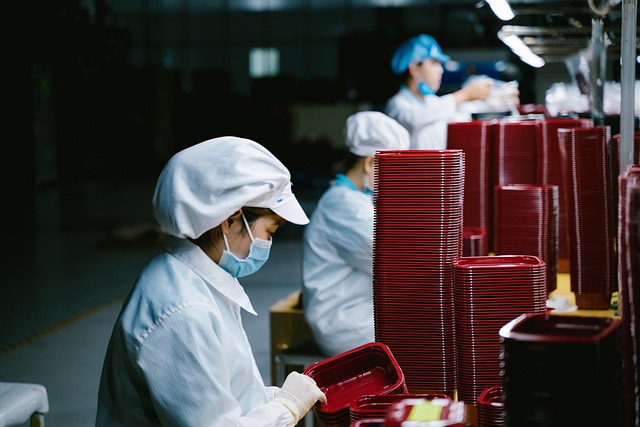The 5S training methodology, a Japanese lean management concept, transforms chaotic workspaces into efficient operations through five key steps: Sort, Set in Order, Shine (clean), Standardize, and Sustain. This systematic approach enhances productivity, fosters quality control, and promotes continuous improvement by encouraging discipline, order, and active employee participation. Implementing 5S training and lean management principles optimizes organizational processes, reduces waste, improves resource allocation, and cultivates a culture of continuous learning and adaptation, ultimately driving operational excellence and competitive advantage.
In today’s competitive business landscape, efficient processes are vital for workplace success. This article explores a powerful framework for process streamlining, focusing on the 5S training methodology and its integration with Lean management principles. We delve into the role of standardization and continuous improvement, offering best practices for sustainable organizational change. By understanding these concepts, businesses can optimize workflows, enhance productivity, and gain a competitive edge in their industry.
- Understanding the 5S Training Methodology: A Foundation for Workplace Organization
- Integrating Lean Management Principles: Streamlining Processes for Efficiency
- The Role of Standardization in Process Improvement: Creating a Consistent Workflow
- Continuous Improvement: Unlocking Potential Through Regular Review and Refinement
- Implementing 5S Framework: Best Practices for Sustainable Organizational Change
Understanding the 5S Training Methodology: A Foundation for Workplace Organization

The 5S training methodology is a powerful tool for transforming disorganized workspaces into lean, efficient operations. This Japanese concept, deeply rooted in lean management principles, focuses on five key steps: Sort, Set in Order, Shine (or Clean), Standardize, and Sustain. Each step builds upon the previous one, creating a systematic approach to workplace organization.
5S continuous improvement involves training employees to meticulously evaluate their work areas, keeping only essential items, arranging them logically, and maintaining a high level of cleanliness. Process standardization is achieved through consistent application of these principles, ensuring every employee follows the same methods for maintaining an organized workspace. This not only enhances productivity but also fosters a culture of quality control and continuous improvement throughout the organization.
Integrating Lean Management Principles: Streamlining Processes for Efficiency

Integrating Lean Management Principles is a pivotal step in any process streamlining framework. By adopting lean management techniques, organizations can achieve significant efficiency gains and enhance overall workplace organization. At the core of this approach lies the 5S training methodology—a system that promotes discipline, order, and continuous improvement. This involves sorting (seiri), setting in order (seiton), shining (seiso), standardizing (seiketsu), and continually reviewing (shitsuke) work areas to eliminate waste and streamline processes.
Effective implementation of 5S principles fosters a culture of workplace organization and process standardization, empowering employees to take ownership of their roles and contribute to ongoing 5S continuous improvement initiatives. This collaborative effort ensures that every step in the production or service delivery process is optimized, leading to increased productivity, reduced waste, and enhanced customer satisfaction.
The Role of Standardization in Process Improvement: Creating a Consistent Workflow

Standardization plays a pivotal role in process improvement by creating a consistent workflow across an organization. This involves implementing structured systems and procedures that ensure every step of a process is clearly defined, repeatable, and efficient. By adopting practices like 5S training and lean management, companies can identify and eliminate waste, streamline operations, and enhance overall productivity.
Workplace organization through process standardization facilitates better resource allocation, reduces errors, and improves quality control. It empowers employees to follow established best practices, fostering a culture of continuous improvement. This approach ensures that everyone is on the same page, working collaboratively to optimize processes and drive business success in a competitive market.
Continuous Improvement: Unlocking Potential Through Regular Review and Refinement

In the realm of process streamlining, Continuous Improvement is a game-changer that empowers organizations to unlock their full potential. Regular reviews and refinements, often facilitated by 5S training and lean management principles, play a pivotal role in achieving this. By implementing 5S continuous improvement strategies, businesses can transform their workplace organization. This involves standardizing processes, sorting through unnecessary steps or clutter, shining a light on hidden issues, setting things in order, and continually striving for perfection—a philosophy at the heart of process standardization.
These regular checks ensure that the workplace remains an efficient, well-oiled machine. They allow for the identification of bottlenecks and areas for enhancement, fostering a culture of constant learning and adaptation. This iterative approach, grounded in 5S principles and lean management, not only optimizes existing processes but also paves the way for innovative solutions, ensuring that organizations stay competitive and relevant in today’s dynamic market.
Implementing 5S Framework: Best Practices for Sustainable Organizational Change

Implementing the 5S Framework is a powerful strategy for organizations seeking to enhance efficiency and create a culture of continuous improvement. This Japanese lean management method focuses on workplace organization, process standardization, and waste elimination. By integrating 5S training into operational practices, businesses can achieve remarkable sustainability in their organizational change efforts.
The 5S methodology comprises five disciplines: Sort, Set in Order, Shine (Clean), Standardize, and Sustain. Each step is designed to optimize the workspace and workflow. For instance, ‘Sort’ involves eliminating unnecessary items, while ‘Set in Order’ ensures everything has a designated place. ‘Shine’ emphasizes regular cleaning for a safe, sanitary environment. Standardization, achieved through consistent application of 5S principles, ensures processes remain efficient over time. This continuous improvement approach fosters a disciplined workforce that actively participates in maintaining and enhancing workplace organization.
